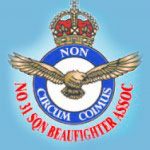Wilbur Wackett
WILBUR LAWRENCE WACKETT (M.l.A.)
(reproduced in part from 31 sqn association newsletter)

The family name “Wackett”, is well known to all who have an interest in Australian aviation history. Sir Lawrence and his younger Brother E.C.Wackett, were engineer officer members of the RAAF, as early as 1923-1924.
Lawrence Wackett’s only Son, Wilbur Lawrence Wackett, entered military service as a RAAF Cadet, becoming a commissioned officer (RAAF No.588), during 1939. Initially, Wilbur was engaged, as a “Test & Ferry Flight Pilot, flying “Wackett and Wirraway Trainers”. During December 1941 Wilbur was posted to No.24 Sqdn, for home Defence training and for combat overseas. Flying Wirraway aircraft, Wilbur spent much of his tour with No 24 Sqdn on anti submarine patrols, along the coastline of Australia.
WACKETT TRAINERS

By early 1942, the rapid advance of Japanese forces had already infested “all points North of Lae, P.N.Guinea” and No.75 Fighter Sqdn was hastily formed, at Townsville, Queensland, on March 4, 1942. (Wilbur’s birthplace, in February,1921.) Equipped with ten Curtis P40 Warhawk (Kittyhawk) fighters, the young pilots only had nine days conversion training, before their long flight deployment, to Port Moresby, P.N.G. on 21st March 1942.
At Port Moresby, anti aircraft gunners, already harassed by Japanese aircraft, opened fire upon the first flight of four P40s arriving at the “Seven Mile Strip”. 3 of the 4 P40s were damaged. But fortunately, no life was lost. (Despite the “embarrassment” incurred in that incident, the final arrival of the “Neverhawks”, was an instant morale boost, to the embattled troops.) Within an hour of arriving, Flying officers Wackett and Cox were scrambled, to intercept a Japanese reconnaissance aircraft. Their attack was swift and they jointly shared the destruction of the intruder, which, in full view of the cheering garrison, exploded into the harbour.
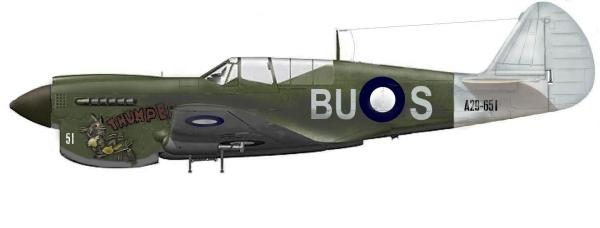
Wilbur was in a flight of 4, led by Flt Lt Peter Turnbull, tasked to provide “top cover”, protecting the 5 P40s, ledby Sqdn Ldr John Jackson, as that flight mounted a concentrated attack, to destroy the enemy base facilities, Just as JohnJackson’s flight commenced their attack, six Zero fighters appeared. Diving, to intersept them, Turnbull,s flight cleared their guns. Wilburs’s gunsight failed and 3 of his guns failed to fire, but he still observed his “tracer” rounds, striking one of the enemy Zeros. As Wilbur pulled up to regain height, his P40 was struck by enemy gunfire, with hostile projectiles penetrating the cockpit around his seat back armourplate and also disabling the engine of his machine.
With his now unpowered P40, rapidly dropping below 1500 feet (too low to safely parachute), Wilbur barely maintained control, until “splashdown”, approximately 10 miles offshore, from the mouth of the Bwang River.
The machine sank immediately, but Wilbur escaped, and swam to the surface, where he inflated his CO2 charged lifejacket. At that time he jettisoned his helmet and flying boots. (Leaving him with ‘the usual kit” of shorts, shirt, sox, gun belt and water bottle). After swimming for some 8 or 9 hours, he reached the shore near a native village named Busamo. Fortunately, some of the natives had previous missionary contact and despite Japanese personnel being in that area, they gave him food and agreed to guide him to safety.
Wilbur’s adventure, which was to preceed his return to his Port Moresby base on Anzac Day 25th April, is too detailed to describe in this brief essay, but, anyone who has experienced a survival situation, could easily visualize, travelling such a long distance through enemy territory by bare feet, native canoes and coastal lugger, whilst suffering the first symptoms of malaria and other disease…….Finally reaching a civilized settlement, Wilbur then travelLed a primitive track to Port Moresby, by motor truck, arriving after being “absent without leave”, for 34 days…….. Wilbur was repatriated with fever and skin diseases, to spend a long convalescence in hospital.
Highlights of his recovery, back in Australia, was his promotion to the rank of Flight Lieutenant and his marriage, to his sweetheart, Miss Peggy Stephenson. Eager to get back to operations, Wilbur was disappointed to learn, that, due to residual malaria in his blood, he was banned from tropical or overseas service, for at least 12 months. His morale did improve, when his wife Peggy, became pregnant and he resumed flying duties, as a test and ferry pilot at Bankstown. His subsequent promotion, to the rank of Squadron Leader, as a young 22 year old, was quite a distinctive recognition, despite being restricted to operations away from malaria risk areas.
Wilbur, keen to get back to “hot flying”, applied for fighter bomber training and qualified as a Beaufighter pilot while he was posted to Bankstown until his posting came up for 31 Sqn at Coomalie Creek NT.
Wilburs posting at Coomalie Creek commenced on 11 August 1944. His first operational sortie was a formation attack upon a Japanese base in Timor. All aircraft returned safely. On Sunday afternoon, 24 September 7944, two Beaufighters (419-208 & A19-192), departed to provide daylight protection for slow flying Catalina flying boats, which were operating between Darwin and Japanese occupied islands, in the Banda Sea performing top Secret Commando resupply, insertion and recovery missions.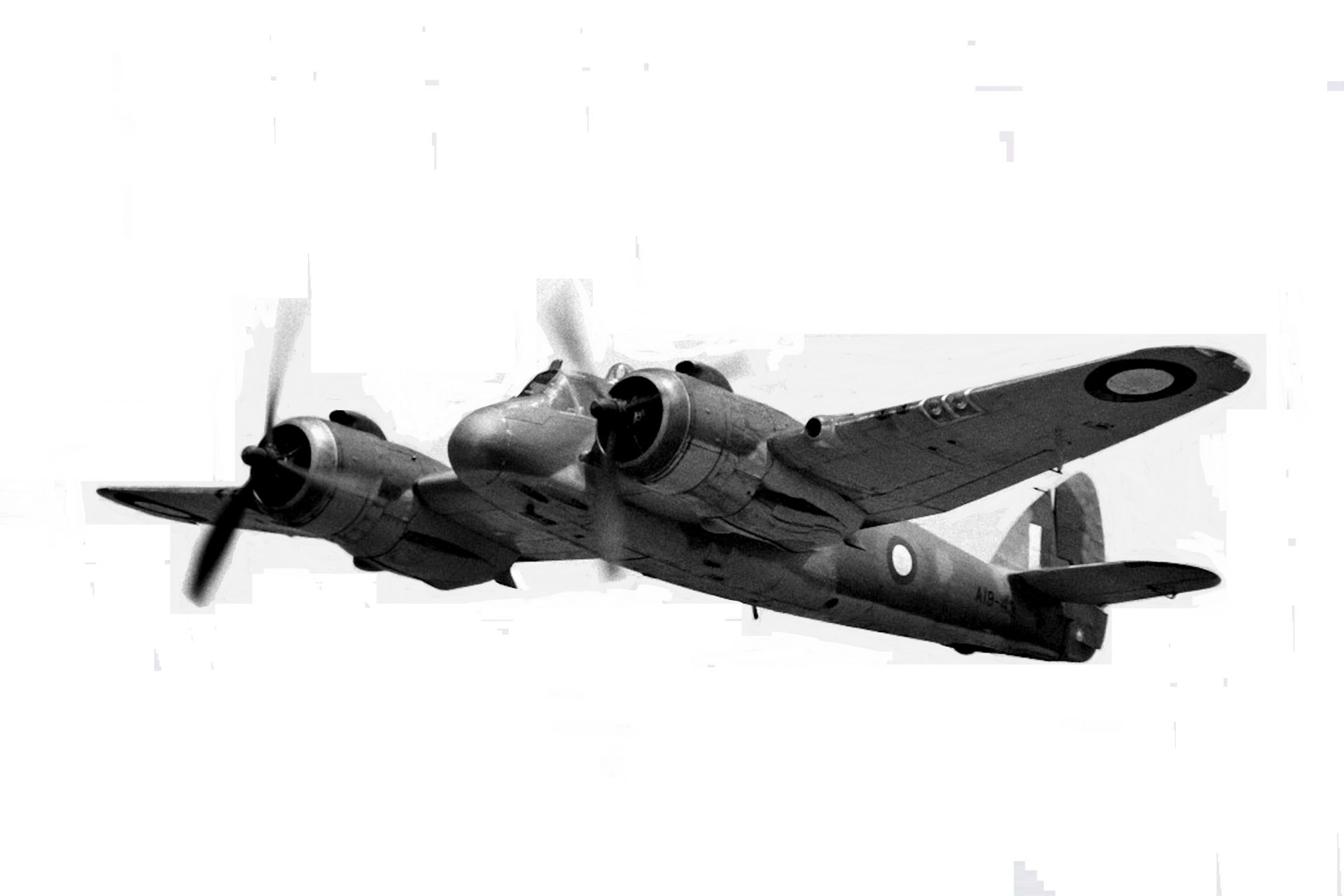 Departing at 1515Hrs, their estimated “safe” endurance indicated that, with “Ops Normal”, the Beaus should find their way back to base, by 2130 Hrs. local time after last light, that night. As the formation headed out over the sea, they left behind the towering coastal grass fire smoke haze, which covers “the top end” at the end of every “Dry Season”. Sometimes so dense that daytime visibility (V.F.R. Ops) can be severely restricted. Even though their ‘kites’ were well worn, the crews were comfortably confident. ln Beau 208, Wilbur trusted his navigator/ wireless operator, F/Off keith Noble and as the pilot of Beau 192 on his wing, P/Off L.F.Ritchie, with his experienced navigator flying Officer “Plum” Warner, were both competent, a long but but trouble free flight was anticipated. The flight over enemy occupied islands failed to attract Jap fighter interception, so,as the dark blue painted Catalinas entered the safety of the evening darkness, the two Beaufighters turned South, to return to the welcoming flare path at Coomalie.
Departing at 1515Hrs, their estimated “safe” endurance indicated that, with “Ops Normal”, the Beaus should find their way back to base, by 2130 Hrs. local time after last light, that night. As the formation headed out over the sea, they left behind the towering coastal grass fire smoke haze, which covers “the top end” at the end of every “Dry Season”. Sometimes so dense that daytime visibility (V.F.R. Ops) can be severely restricted. Even though their ‘kites’ were well worn, the crews were comfortably confident. ln Beau 208, Wilbur trusted his navigator/ wireless operator, F/Off keith Noble and as the pilot of Beau 192 on his wing, P/Off L.F.Ritchie, with his experienced navigator flying Officer “Plum” Warner, were both competent, a long but but trouble free flight was anticipated. The flight over enemy occupied islands failed to attract Jap fighter interception, so,as the dark blue painted Catalinas entered the safety of the evening darkness, the two Beaufighters turned South, to return to the welcoming flare path at Coomalie.
Both aircraft had “blind flying navigation instruments”, but in the black night, when entering the coastal smoke and dust haze, which hung thickly in the almost still evening air, their navigation was, to a large degree, by “dead reckoning”. Maintaining mandatory radio silence, the only way that the pilots could remain in formation, was by occasional glimpses of the aircraft navigation lights. ln their swivel based back seats, the navigators, hunched over their wireless sets, scanning radio frequencies, seeking (‘homer” signals,transmitted from ground stations,to guide them to ANY aerodrome.
Surviving AL9-L92 navigator “Plum Warner, later lamented, that he was unable to receive any signal. Which was strong enough. ln the moonless night, with only minimal fuel remaining, the two crews, guided only by magnetic compass and “dead reckoning”calculation skills, flew on, hoping to sight a flashing airfield beacon. Meanwhile, as the aircraft had, by elapsed time,been declared overdue, The Fighter Sector Control Unit had alerted all stations on their landline and HF wireless network. Searchlights swept the night sky and RDF (Radar) stations searched for ANY aircraft or, an identifying IFF radio signal, indicating an “Aircraft in distress” transmission.
Late in the night, when the Beaufighter’s estimated fuel endurance had expired, radar operators observed a ‘screen blip near Cape Hotham, Nth.East of Darwin, but attempts to communicate by wireless gained no response. lmage Tracking continued, until Two friendly aircraft’were identified, North of Fenton Aerodrome. One aircraft was circling, whilst the other, broke formation and headed East. As the image indicating the circling machine disappeared, the fading image of the other machine was tracked, to interpret height, distance and direction. At first light next morning (25 Sept), a ground party, equipped with 4WD vehicles, HF wireless and supplies for many days, departed from Coomalie, led by 31 Sqdn Engineer Officer, Frank Stewart. At Batchelor, low flying slow biplanes of No 6 Comm. Flight, led by legendary Flying Doctor, Sqdn ldr Clyde Fenton, commenced an aerial search.
The first glimmer of hope came, that morning, when A19-192 navigator F/Off ‘Plum’Warner was found, near the Brocks Creek siding. on the railway and overland telegraph lines. Warner reported, that he had been ordered, to leave the circling A19-192 by parachute and during his descent, had heard the machine crash, North of the railway. The fire blackened wreckage of ‘192’ was quickly spotted and having received direction and distance information, SqdnLdr Stewart proceeded across country in a 4WD Command Car, in the hope that P/Off Ritchie may be found alive. Careful examination of the scattered Beau wreckage, found no evidence that the pilot had perished, in the aircraft. Sadly, despite extensive ground searches (lncluding a turn out of inmates from the nearby Military detention facility) plus more recent intensive mineral prospecting and cattle mustering, no trace of PltOff Ritchie has been discovered to this day.
With ‘the circling aircraft identified as A19-192, all available aircraft searched along the radar track, of what had to be A19-208. Those aerial searches gridded a wide area along and well beyond the easterly heading which had been observed on radar sets, as it was then assumed, that, believing they had drifted West of their planned route, due to the prevailing Sth. Easterly winds, Wackett and Noble had headed East, hoping to sight the Nth.South railway or roadway.The sustained aerial searches found no trace of the missing aircraft or its ill fated crew. lt was not until October 1945 when stockmen mustering cattle, discovered aircraft wreckage, in a tributary of Goodparla Creek, some 50 miles Nth.East of the crash site of A19-192. Having received a report of the discovery, a RAAF investigative party was guided to the sight on 21 November 1945.
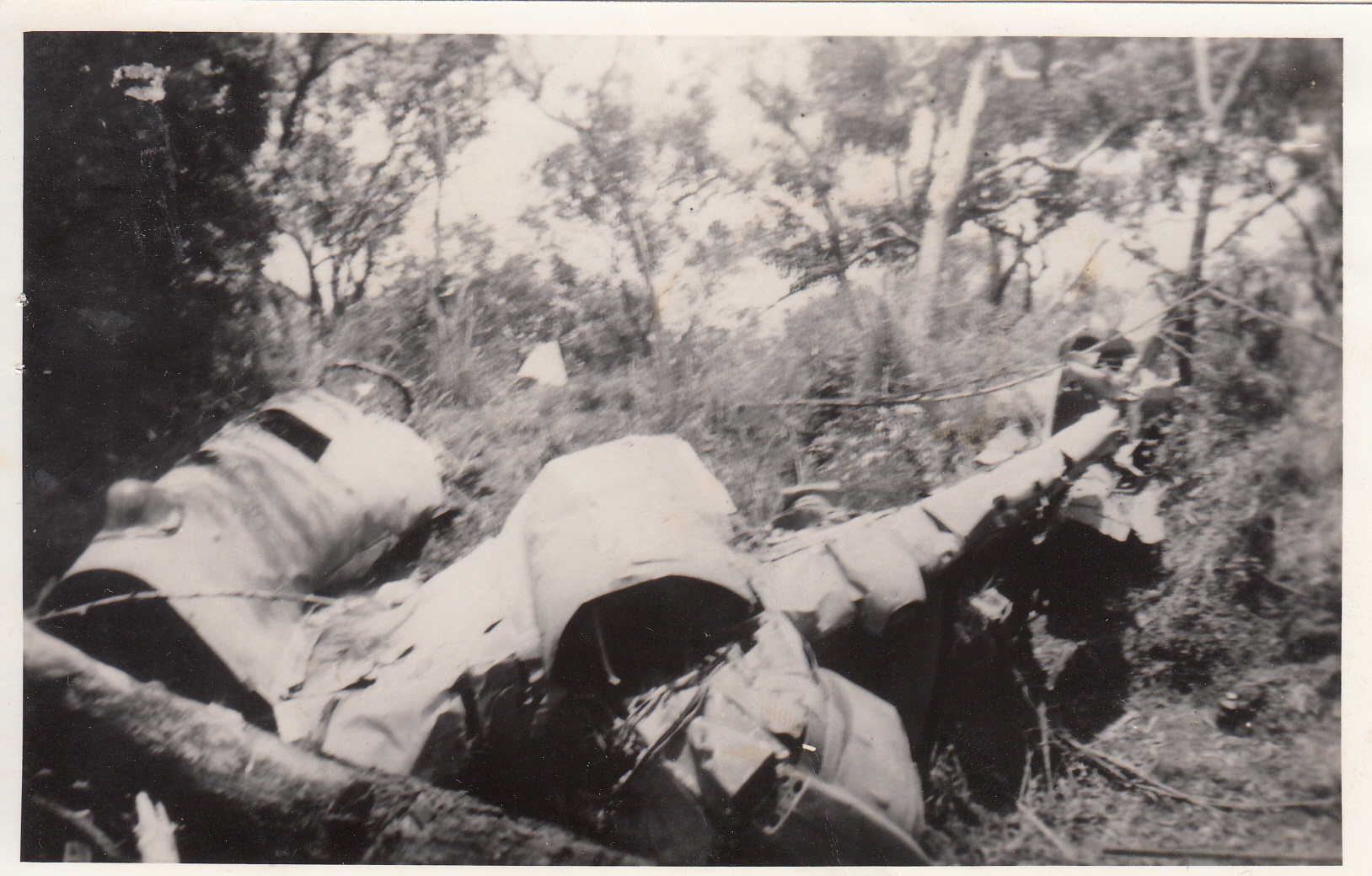
The RAAF technical inspection confirmed that the wreck was (a) A19-208, (b) there was no trace of crew, or personal equipment, (c) The forward escape hatch was open at time of impact. A search of the surrounding area (including excavating creek bed gravel), found no evidence of the crew, who were presumed to have left the aircraft by parachutes. Subsequent aerial and ground searches over the surrounding rough terrain, led by mounted police and skilled bushmen, failed to find any trace of the crew, before their fate became ‘just another missing personnel file, in the RAAF Casualty Section, at the Federal Department of Air.
SEARCH PARTY LED BY FRED ANDERSON PREPARING TO LOOK FOR WILBUR
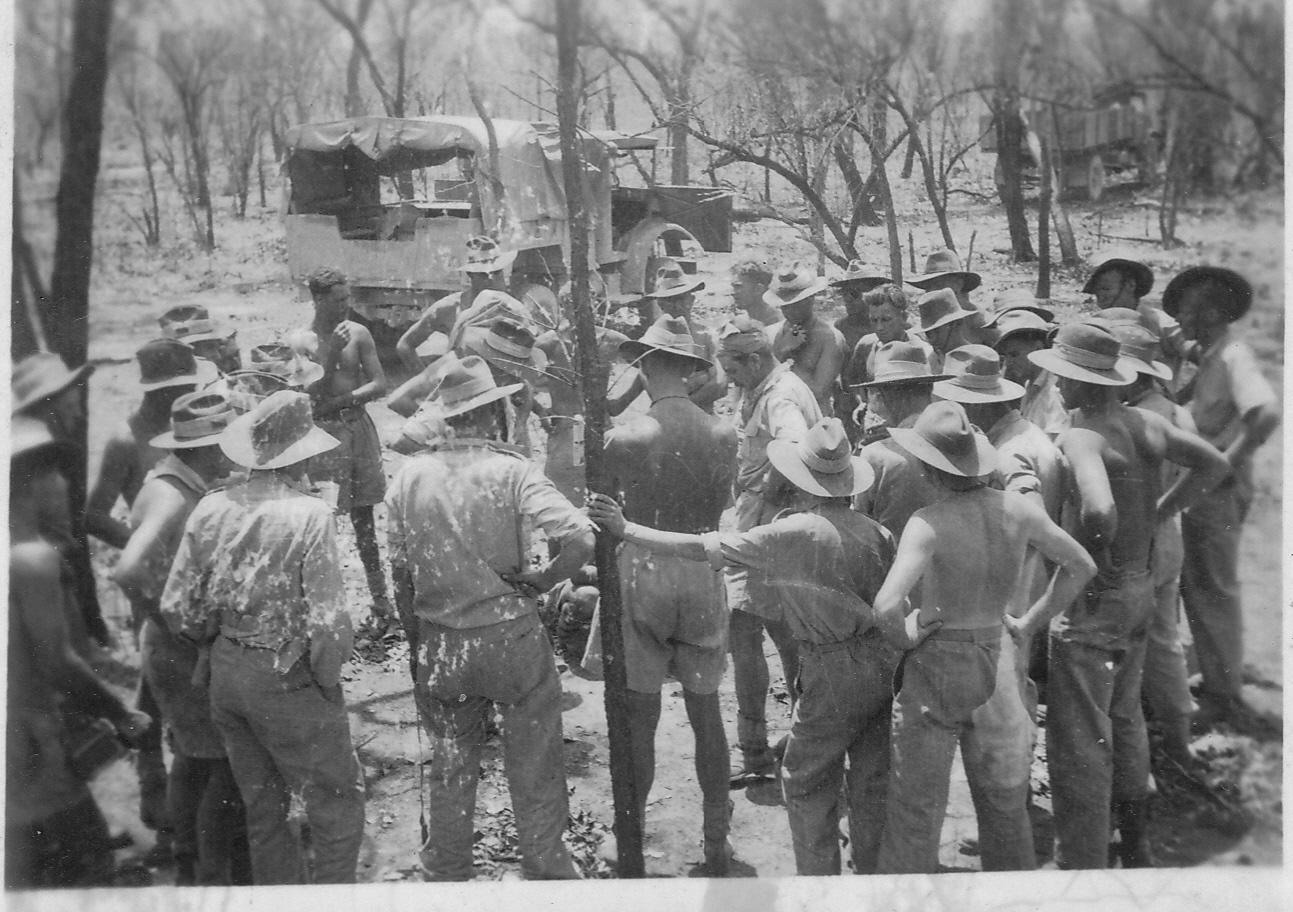
Wilbur Wackett’s Father (Later Sir Lawrence Wackett), having discussed with his only Son, the determined survival achieved in New Guinea, refused to give up hope. He believed that somehow, Wilbur would have survived. L.J.Wackett’s representations, resulted in NT Mounted Constable E.H.Morey, being sent from Pine Creek in May 1946 to carry out more wide ranging ground searches. The meticulous survey, conducted by Mounted Constable Morey and his aboriginal assistant, is, in itself, another adventure story.
On a low ridge, some 400 metres from the wreck, something unusual was sighted and investigated. Const.Morey identified the rotting remains of a parachute, tied to a spindly tree, with the remains of a personal survival dinghy or inflatable vest below and scattered nearby, he found opened military issue survival ration tins. This discovery motivated another extended search, which included burning off the tall tropical grass, but no other evidence was found. Who was the person, who having spread the parachute canopy, both as shade, but, more desperately, hoping it would be spotted by searching aircraft overhead? Now,more than 60 years later, the fate of the three missing airmen, is still an unsolved mystery.
The A19-208 crash site is now in a restricted access ‘regeneration area’ of Kakadu National Park. A stone and cement cairn, surmounted by the late Sir Lawrence Wackett’s Family Coat of Arms, erected by members of Wilbur’s still active No75 Fighter Sqdn. ls a permanent guardian, overlooking the A19-208 crash site.
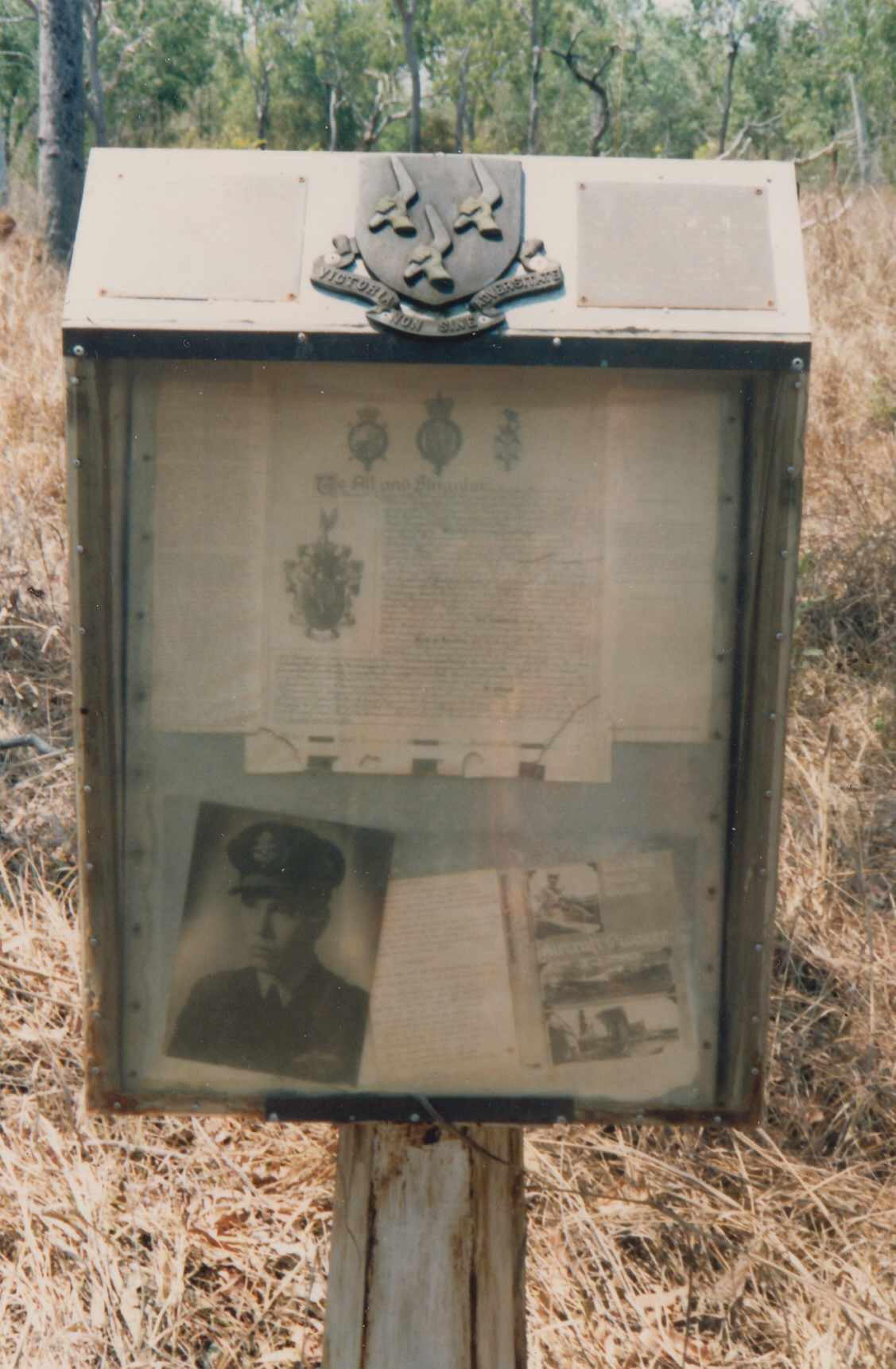
Click on link below to see Wilbur Wackett’s service history
